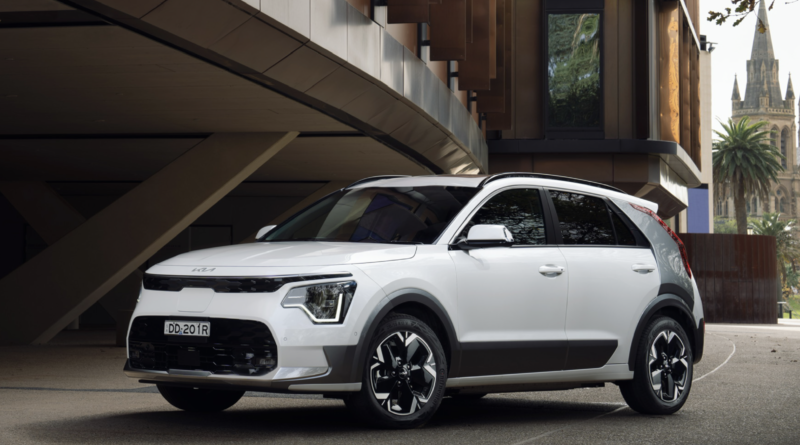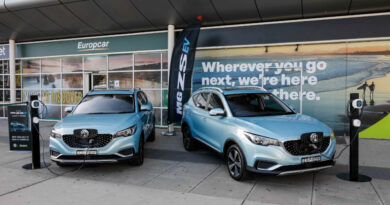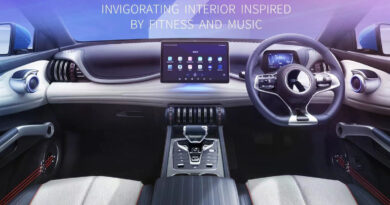Kia Niro EV review: All-electric SUV arrives to sit below the EV6
Kia Niro EV review: It was only in 2021 that Kia introduced the Niro nameplate to Australia. Now that nameplate newcomer is already being replaced by an all-new model – just a year after the arrival of the original.
Blame it on the late arrival of that first model. Australia received the Niro very late in its model cycle and it was never intended to be a stayer. Instead, it was more about dipping a toe in the electrified water and getting the Kia dealer network ready or the EV onslaught.
While brief, the original Niro’s fleeting lifespan also helped Kia Australia better understand the EV market and what consumers want. That’s why this time around they’ve decided to truncate the model lineup.
Whereas the original Niro was available as a regular hybrid, a plug-in hybrid (PHEV) and a battery electric vehicle (EV), the new model does without the PHEV option.

So instead it’s hybrid and EV tech for Kia’s new entry-level electrified SUV.
The compact SUV sits under the EV6 from a pricing perspective.
But whereas the EV6 is based on a dedicated EV architecture, the Niro relies on an ICE platform to allow for the petrol engine for the hybrid model.
For this review we’re focusing on the EV version of the Niro, which Kia also believes will be the biggest seller; it helps that not many Niros will be coming to Australia, with Kia initially saying it would be getting only about 75 per month.
Value
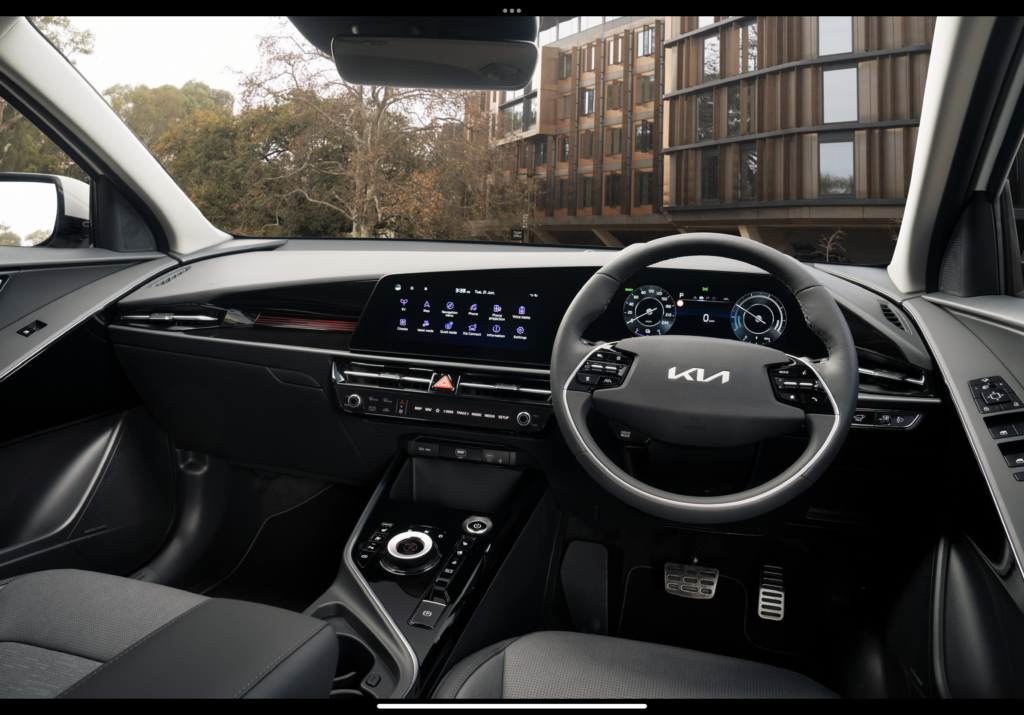
The second-generation Niro comes as a hybrid or an EV, the latter commanding a big price premium.
But even as a hybrid the Niro doesn’t come particularly cheap. The starting price is $44,380 plus on-road costs, making it a lot more expensive than rival hybrids, mostly from Toyota.
It’s the EV we’re testing here and it comes with more gear than the hybrid. It’s available as an entry-level Niro S EV, priced from $65,300 or a better equipped Niro GT-Line EV at a hefty $72,100.
There’s a healthy smattering of equipment in the S, including wireless Apple CarPlay and Android Auto, smart key entry, powered driver’s seat, auto headlights and wipers, dual-zone ventilation and a fully digital instrument cluster. The central infotainment screen measures 8.0 inches in diameter.
Up front there are USB-A and USB-C plugs, while those in the rear can access USB-C plugs build into the sides of the front seats.
There’s also digital radio tuning as well as AM radio tuning, the latter a rarity in EVs due to the potential for interference that leads to poor reception.
Safety is taken care of with eight airbags (including a centre airbag between the front occupants), autonomous emergency braking (AEB), blind spot warning and a safe exit warning that alerts if another vehicle is approaching and someone is about to open a door.
All Niro EVs run on 17-inch alloy wheels shod in Continental tyres.
The Niro GT-Line EV tested here adds front parking sensors, heated and ventilated front seats, sunroof, head-up display, tinted rear windows, heated steering wheel, auto up/down windows, alloy pedals, ambient lighting, wireless phone charging and an eight-speaker Harman Kardon sound system.
There’s also a nicer fake leather trim as well as a larger 10.25-inch infotainment screen, although the addition of satellite-navigation means it drops the wireless smartphone connectivity, with users instead having to plug in if they want to use Apple CarPlay or Android Auto.
The GT-Line also gets Kia’s first telematics system, known as Kia Connect. It allows remote functionality such as locking or unlocking the doors and activating the ventilation, all done via a smartphone app. There’s also detailed data logging and the ability to automatically contact a call centre in the event of a crash. Plus Kia Connect has a Valet Mode that can limit infotainment use and remotely monitor speed and location, even alerting the owner if the person behind the wheel exceeds a pre-set speed limit or leaves or enters a pre-determined area. There’s also a system called Remote Smart Park Assist, which allows the car to be driven forward or backwards slowly via the remote keyfob.
Plus those who choose blue, green or white in the GT-Line get a contrasting C-pillar colour.
As with other Kias, the Niro EV is covered by a seven-year, unlimited kilometre warranty. However, the high voltage battery warranty is capped at 150,000km, which is slightly less than most other electric cars.
Inside

The Niro has seating for five in what is officially a compact SUV body. But it’s spacious by compact SUV standards, with good head and leg room for adults in the rear.
It measures in a 4420mm in length, 1825mm in width, and 1570mm in height, and it rides on a 2720mm wheelbase.
There’s also an upmarket ambience that is streets ahead of the original. Plastics and materials are more in line with newer Kia offerings, creating a cabin ambience vaguely in line with the premium pricing.
The dashboard looks modern and classy and blends nicely with the digital instrument cluster. Ambient lighting in the GT-Line lifts it further.
The smaller 8.0-inch screen of the Niro S EV looks undernourished, but the GT-Line’s larger screen better fleshes out the space.
For luggage, you can expect 475 litres of room, measured to the VDA standard. However, some of that space is under the boot floor where a spare tyre sits in hybrid models. The boot floor also has an adjustable height, allowing you to utilise some of that underfloor space in the main luggage compartment.
There’s also another 20 litres of luggage space under the bonnet. It’s a compact covered binnacle but can be handy for stashing lesser used items of charging cables.
Performance and efficiency

The basics with the Niro EV haven’t changed much. It still uses a single electric motor driving the front wheels.
But the motor has been tweaked to make less torque – and not just a little bit.
The previous Niro made 150kW and 400Nm. The new one matches the 150kW but now musters only 255Nm, which is a serious downgrade.
Kia says it’s been done to improve driveability and reduce the chance of wheelspin when giving it a healthy dose of right foot from a standstill.
That has certainly been improved with Niro MkII and, strangely, there’s still decent pull at suburban speeds.
Power comes on smoothly and swiftly, ensuring you can easily and regularly utilise the full 255Nm.
However, efficiency has slipped slightly in this newer Niro, which now uses a claimed average of 16.2kWh per 100km. Not bad, but outclassed by some of the EVs built on a dedicated electric car platform.
Charging
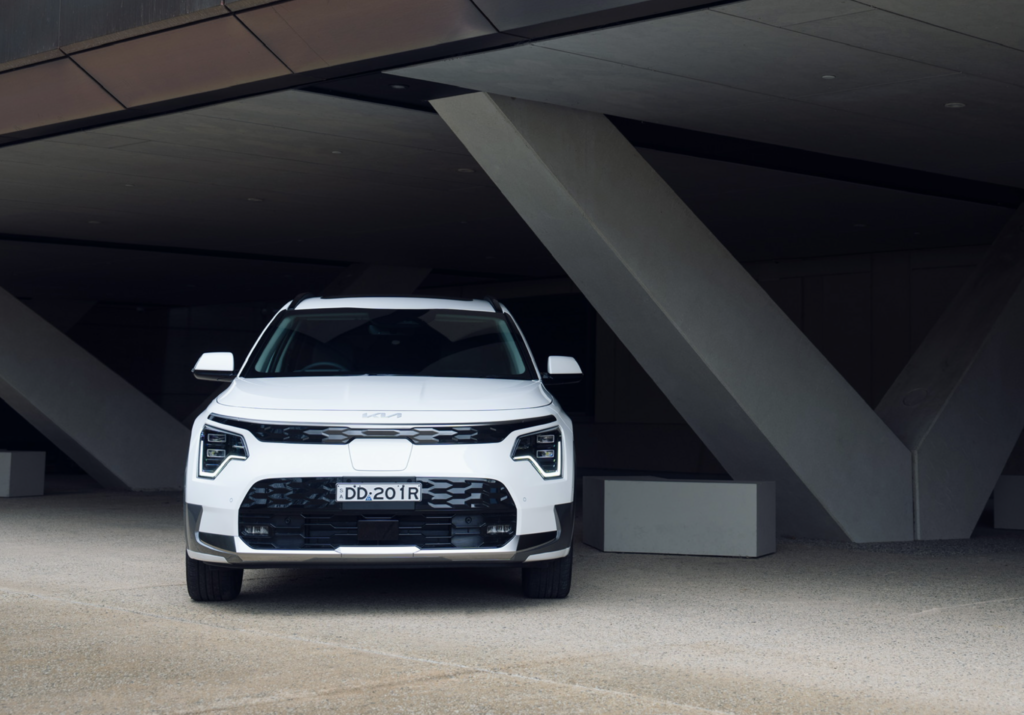
The Niro has the industry standard CCS combo plug that utilises the Type 2 system for slower AC charging.
That AC charging can be done at up to 11kW, allowing for a full charge in about 6.5 hours. A full charge from a regular household powerpoint would take more like 29 hours.
Kia doesn’t quote a maximum charge power when using faster DC charging, instead cheekily pointing out it can be charged from a 350kW charger (as any other EV capable of DC charging can).
However, it appears the maximum charging power is around 105kW, possibly 110kW. Our estimation is based on Kia’s charge time claims. A 10-80 percent charge from a 100kW charger is claimed to take about 45 minutes, whereas using a charger with more power (anything up to 350kW) lowers that by only two minutes, to 43 minutes total.
In other words, it’s not drawing much more maximum power when plugged in to a charger capable of supplying more than 100kW.
Ride and handling
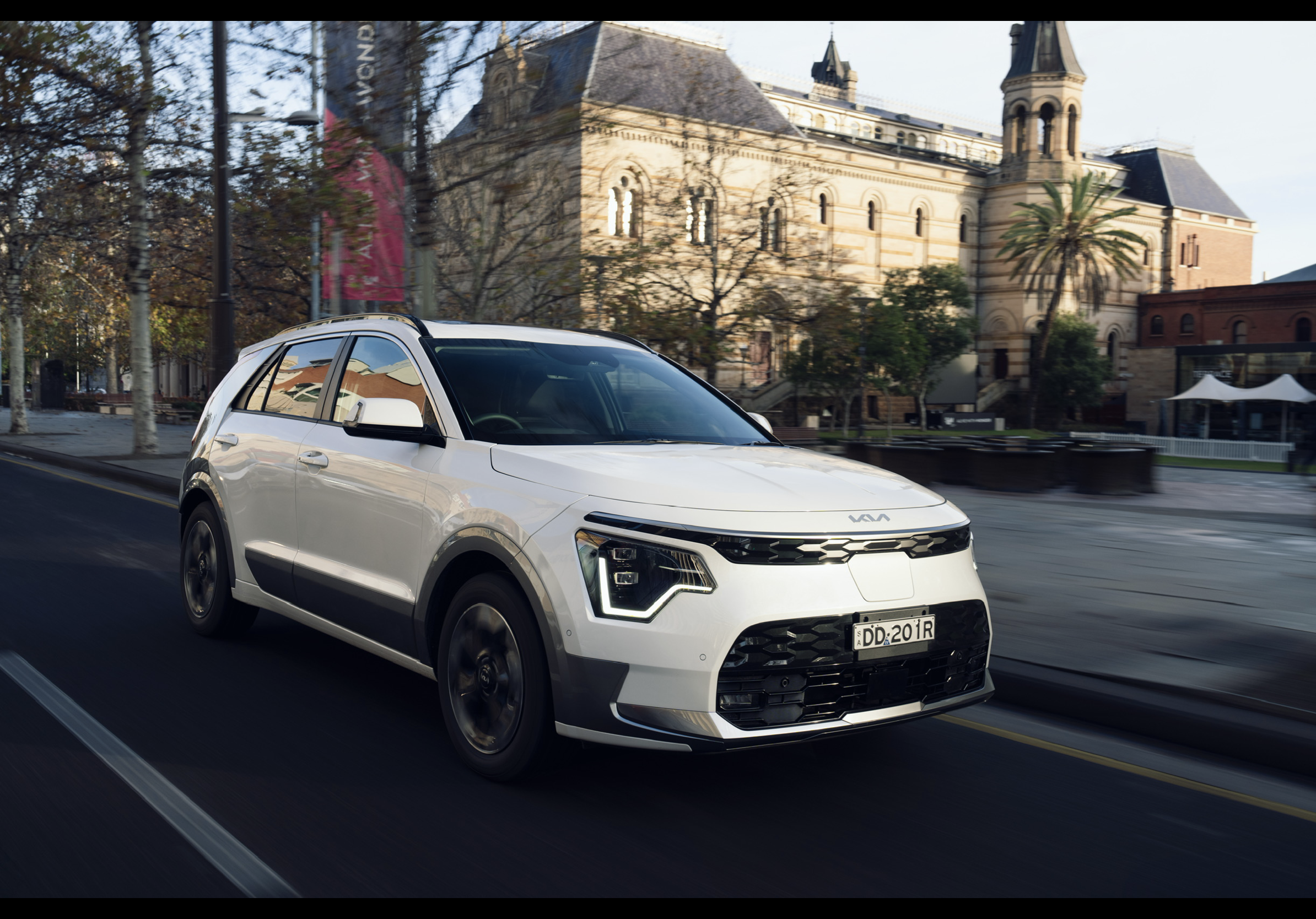
Like all modern Kias, the Niro has been treated to a comprehensive ride and handling localisation program, with the brand’s suspension gurus submitting the new EV to plenty of testing to get the balance just right.
And…. it’s worked. While the Niro definitely lacks the eyebrow-peeling acceleration we’ve come to associate with some relatively affordable electric vehicles (we’re looking at you, Tesla Model 3 Performance), it has swapped it for a sense of all-around liveability and a silky-smooth drive experience that really invites no criticism.
The steering feels well-weighted (not too light, but not like you’re trying to open a stubborn jar of pickles either). And the ride strikes a commendable balance between on-road connection and comfort – you can definitely feel the road’s bumps, but it’s never uncomfortable – and it all combines to deliver a genuinely easy and stress-free drive experience.
Push the Niro a little faster through tighter bends and you’ll definitely notice the added weight of the batteries beneath your feet, but there’s not much in the way of body roll, and you’d have to try really hard to get the tyres to squeal, too.
Some EVs are known for their acceleration, others (hello Porsche) for their cornering dynamics, and while the Niro won’t steal those headlines, it does all the little important things well.
Talking point
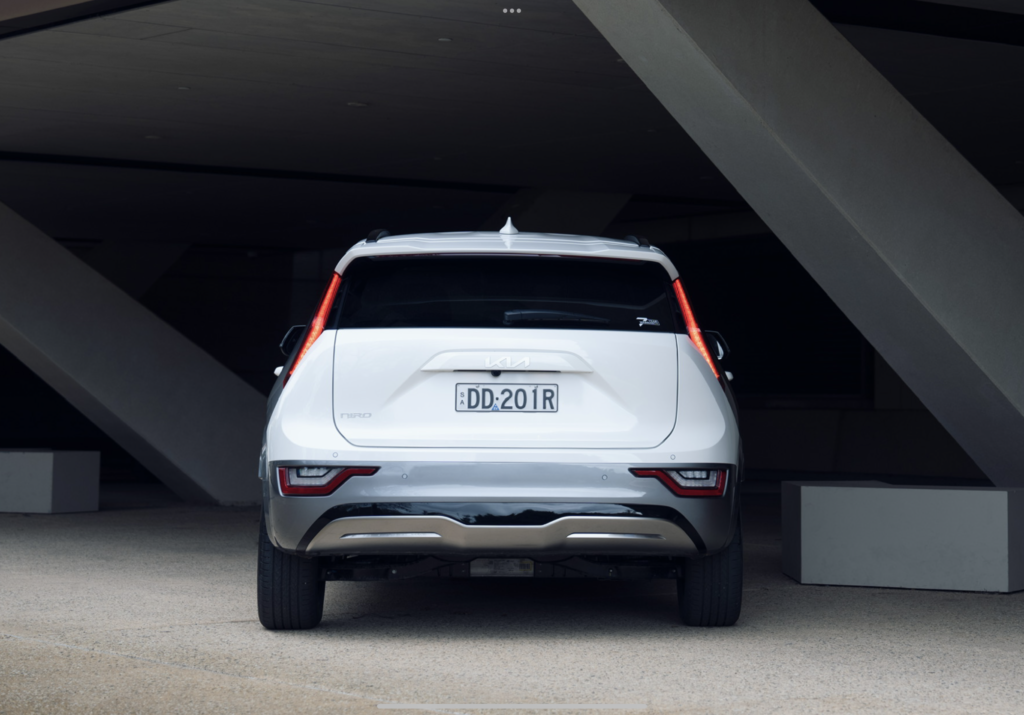
The previous Niro could tow a modest 300kg, but the new one steps that up to 750kg. So as well as a box trailer you may be able to fit a small tinnie or other watercraft.
The Niro GT-Line also has additional party tricks. For those trying to park into the narrowest parking spot available they’ll be able to do so from outside the car. The Remote Smart Park Assist (RSPA) system allows the car to be driven slowly forward and backwards via the keyfob. We’re pretty sure most people will probably use it to show off to friends more than they will to slide into a tight space, but anyway…
Safety
The Niro EV gets a maximum complement of airbags, including dual front, front side, side curtain, a driver’s knee airbag and an airbag between the front occupants.
There’s also a strong suite of active safety equipment, starting with tyre pressure sensors (there’s no spare tyre, only a tyre repair kit).
Other systems include autonomous emergency braking (AEB), blind spot warning, rear cross traffic alert and lane keep assist with lane following, the latter two relatively ineffective during our brief drives. There’s also safe exit warning to alert occupants of an approaching vehicle while parked.
Omissions include a 360-degree camera (the Niro only gets a regular reversing camera).
Kia Niro EV review: Verdict

There’s a lot to like about the Kia Niro. It’s got plenty of nice cabin tech, an easy, breezy driving style, and more space than you might normally find in an EV of this size. Its price, though – especially in GT-Line guise – could prove a sticking point for some.
Kia Niro EV review specifications
Price: $65,300 (Niro S EV), $72,100 (Niro GT-Line EV), plus on-road costs
Basics: EV, SUV, 5 seats, FWD
Range: 460km (WLTP)
Battery capacity: 64.8kWh
Battery warranty: 7 years/150,000km
Energy consumption: 16.2kWh/100km
Motors: 1 front 150kW/255Nm
AC charging: 11kW, Type 2 plug
DC charging: 105kW (estimated), CCS combo plug
0-100km/h: 7.8 seconds (claimed)

